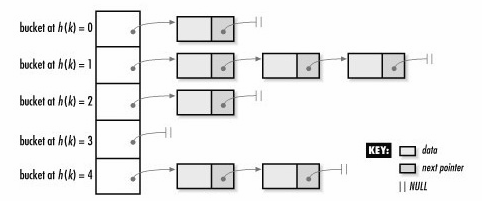關聯容器:unordered_map詳細介紹(附可執行程式碼)
1.介紹
最近使用到一個c++的容器——unordered_map,它是一個關聯容器,內部採用的是hash表結構,擁有快速檢索的功能。
1.1 特性
- 關聯性:通過key去檢索value,而不是通過絕對地址(和順序容器不同)
- 無序性:使用hash表儲存,內部無序
- Map : 每個值對應一個鍵值
- 鍵唯一性:不存在兩個元素的鍵一樣
- 動態記憶體管理:使用記憶體管理模型來動態管理所需要的記憶體空間
1.2 Hashtable和bucket
由於unordered_map內部採用的hashtable的資料結構儲存,所以,每個特定的key會通過一些特定的雜湊運算對映到一個特定的位置,我們知道,hashtable是可能存在衝突的(多個key通過計算對映到同一個位置),在同一個位置的元素會按順序鏈在後面。所以把這個位置稱為一個bucket是十分形象的(像桶子一樣,可以裝多個元素)。可以參考
所以unordered_map內部其實是由很多雜湊桶組成的,每個雜湊桶中可能沒有元素,也可能有多個元素。
2. 模版
template < class Key, // unordered_map::key_type
class T, // unordered_map::mapped_type
class Hash = hash<Key>, // unordered_map::hasher 主要使用的也是模板的前2個引數<鍵,值>(需要更多的介紹可以點選這裡)
unordered_map<const Key, T> 2.1 迭代器
unordered_map的迭代器是一個指標,指向這個元素,通過迭代器來取得它的值。
unordered_map<Key,T>::iterator it;
(*it).first; // the key value (of type Key)
(*it).second; // the mapped value (of type T)
(*it); // the "element value" (of type pair<const Key,T>) 它的鍵值分別是迭代器的first和second屬性。
it->first; // same as (*it).first (the key value)
it->second; // same as (*it).second (the mapped value) 3. 功能函式
3.1 建構函式
unordered_map的構造方式有幾種:
- 構造空的容器
- 複製構造
- 範圍構造
- 用陣列構造
3.1.2示例程式碼
// constructing unordered_maps
#include <iostream>
#include <string>
#include <unordered_map>
using namespace std;
typedef unordered_map<string,string> stringmap;
stringmap merge (stringmap a,stringmap b) {
stringmap temp(a); temp.insert(b.begin(),b.end()); return temp;
}
int main ()
{
stringmap first; // 空
stringmap second ( {{"apple","red"},{"lemon","yellow"}} ); // 用陣列初始
stringmap third ( {{"orange","orange"},{"strawberry","red"}} ); // 用陣列初始
stringmap fourth (second); // 複製初始化
stringmap fifth (merge(third,fourth)); // 移動初始化
stringmap sixth (fifth.begin(),fifth.end()); // 範圍初始化
cout << "sixth contains:";
for (auto& x: sixth) cout << " " << x.first << ":" << x.second;
cout << endl;
return 0;
}輸出結果:
sixth contains: apple:red lemon:yellow orange:orange strawberry:red
3.2 容量操作
3.2.1 size
size_type size() const noexcept;
返回unordered_map的大小
3.2.2 empty
bool empty() const noexcept;
- 為空返回true
- 不為空返回false,和用size() == 0判斷一樣。
3.3 元素操作
3.3.1 find
iterator find ( const key_type& k );
查詢key所在的元素。
- 找到:返回元素的迭代器。通過迭代器的second屬性獲取值
- 沒找到:返回unordered_map::end
3.3.2 insert
插入有幾種方式:
- 複製插入(複製一個已有的pair的內容)
- 陣列插入(直接插入一個二維陣列)
- 範圍插入(複製一個起始迭代器和終止迭代器中間的內容)
- 陣列訪問模式插入(和陣列的[]操作很相似)
具體的例子可以看後面示例程式碼。
3.3.3 at
mapped_type& at ( const key_type& k );
查詢key所對應的值
- 如果存在:返回key對應的值,可以直接修改,和[]操作一樣。
- 如果不存在:丟擲 out_of_range 異常.
mymap.at(“Mars”) = 3396; //mymap[“Mars”] = 3396
3.3.4 erase
擦除元素也有幾種方式:
通過位置(迭代器)
iterator erase ( const_iterator position );通過key
size_type erase ( const key_type& k );通過範圍(兩個迭代器)
iterator erase ( const_iterator first, const_iterator last );
3.3.5 clear
void clear() noexcept
清空unordered_map
3.3.6 swap
void swap ( unordered_map& ump );
交換兩個unordered_map(注意,不是交換特定元素,是整個交換兩個map中的所有元素)
3.3.7 示例程式碼
// unordered_map::insert
#include <iostream>
#include <string>
#include <unordered_map>
using namespace std;
void display(unordered_map<string,double> myrecipe,string str)
{
cout << str << endl;
for (auto& x: myrecipe)
cout << x.first << ": " << x.second << endl;
cout << endl;
}
int main ()
{
unordered_map<string,double>
myrecipe,
mypantry = {{"milk",2.0},{"flour",1.5}};
/****************插入*****************/
pair<string,double> myshopping ("baking powder",0.3);
myrecipe.insert (myshopping); // 複製插入
myrecipe.insert (make_pair<string,double>("eggs",6.0)); // 移動插入
myrecipe.insert (mypantry.begin(), mypantry.end()); // 範圍插入
myrecipe.insert ({{"sugar",0.8},{"salt",0.1}}); // 初始化陣列插入(可以用二維一次插入多個元素,也可以用一維插入一個元素)
myrecipe["coffee"] = 10.0; //陣列形式插入
display(myrecipe,"myrecipe contains:");
/****************查詢*****************/
unordered_map<string,double>::const_iterator got = myrecipe.find ("coffee");
if ( got == myrecipe.end() )
cout << "not found";
else
cout << "found "<<got->first << " is " << got->second<<"\n\n";
/****************修改*****************/
myrecipe.at("coffee") = 9.0;
myrecipe["milk"] = 3.0;
display(myrecipe,"After modify myrecipe contains:");
/****************擦除*****************/
myrecipe.erase(myrecipe.begin()); //通過位置
myrecipe.erase("milk"); //通過key
display(myrecipe,"After erase myrecipe contains:");
/****************交換*****************/
myrecipe.swap(mypantry);
display(myrecipe,"After swap with mypantry, myrecipe contains:");
/****************清空*****************/
myrecipe.clear();
display(myrecipe,"After clear, myrecipe contains:");
return 0;
}輸出結果:
myrecipe contains:
salt: 0.1
milk: 2
flour: 1.5
coffee: 10
eggs: 6
sugar: 0.8
baking powder: 0.3
found coffee is 10
After modify myrecipe contains:
salt: 0.1
milk: 3
flour: 1.5
coffee: 9
eggs: 6
sugar: 0.8
baking powder: 0.3
After erase myrecipe contains:
flour: 1.5
coffee: 9
eggs: 6
sugar: 0.8
baking powder: 0.3
After swap with mypantry, myrecipe contains:
flour: 1.5
milk: 2
After clear, myrecipe contains:
3.4 迭代器和bucket操作
3.4.1 begin
iterator begin() noexcept;
local_iterator begin ( size_type n );
- begin() : 返回開始的迭代器(和你的輸入順序沒關係,因為它的無序的)
- begin(int n) : 返回n號bucket的第一個迭代器
3.4.2 end
iterator end() noexcept;
local_iterator end( size_type n );
- end(): 返回結束位置的迭代器
- end(int n) : 返回n號bucket的最後一個迭代器
3.4.3 bucket
size_type bucket ( const key_type& k ) const;
返回通過雜湊計算key所在的bucket(注意:這裡僅僅做雜湊計算確定bucket,並不保證key一定存在bucket中!)
3.4.4 bucket_count
size_type bucket_count() const noexcept;
返回bucket的總數
3.4.5 bucket_size
size_type bucket_size ( size_type n ) const;返回第i個bucket的大小(這個位置的桶子裡有幾個元素,注意:函式不會判斷n是否在count範圍內)
3.4.6 示例程式碼
// unordered_map::bucket_count
#include <iostream>
#include <string>
#include <unordered_map>
using namespace std;
int main ()
{
unordered_map<string,string> mymap =
{
{"house","maison"},
{"apple","pomme"},
{"tree","arbre"},
{"book","livre"},
{"door","porte"},
{"grapefruit","pamplemousse"}
};
/************begin和end迭代器***************/
cout << "mymap contains:";
for ( auto it = mymap.begin(); it != mymap.end(); ++it )
cout << " " << it->first << ":" << it->second;
cout << endl;
/************bucket操作***************/
unsigned n = mymap.bucket_count();
cout << "mymap has " << n << " buckets.\n";
for (unsigned i=0; i<n; ++i)
{
cout << "bucket #" << i << "'s size:"<<mymap.bucket_size(i)<<" contains: ";
for (auto it = mymap.begin(i); it!=mymap.end(i); ++it)
cout << "[" << it->first << ":" << it->second << "] ";
cout << "\n";
}
cout <<"\nkey:'apple' is in bucket #" << mymap.bucket("apple") <<endl;
cout <<"\nkey:'computer' is in bucket #" << mymap.bucket("computer") <<endl;
return 0;
}
輸出結果:
mymap contains: door:porte grapefruit:pamplemousse tree:arbre apple:pomme book:livre house:maison
mymap has 7 buckets.
bucket #0's size:2 contains: [book:livre] [house:maison]
bucket #1's size:0 contains:
bucket #2's size:0 contains:
bucket #3's size:2 contains: [grapefruit:pamplemousse] [tree:arbre]
bucket #4's size:0 contains:
bucket #5's size:1 contains: [apple:pomme]
bucket #6's size:1 contains: [door:porte]
key:'apple' is in bucket #5
key:'computer' is in bucket #6
最後
unordered_map常用的功能函式介紹就這麼多了,還有一些比較不常用的功能的介紹,可以參考這裡

